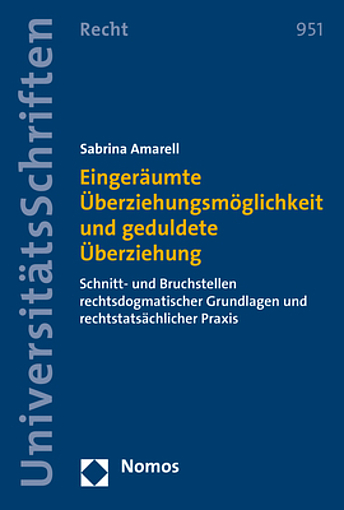englischTogether with a current account and a debit or credit card, having an overdraft granted and tolerated is a basic element of financial services for consumers. The far-reaching and profound changes to the law on consumer loans connected to the implementation of the Consumer Credit Directive (2008/48/EC) resulted especially in the redefinition of the right to have an overdraft both granted and tolerated according to §§ 504 and 505 respectively of Germany’s civil code (Bürgerliches Gesetzbuch). In 2016, these reforms were supplemented by further changes to the law, which significantly altered the right to be given an overdraft and which resulted from the implementation of both the Mortgage Credit Directive (2014/17/EU) and the Payment Account Directive (2014/92/EU). Using these changes as a starting point, this study examines the legal dogmatic foundations of having an overdraft granted and tolerated in both a European and a national context. Subsequently, it conducts an empirical investigation into practical experiences with overdrafts, which is based on interviews with experts from both credit institutes from the three banking sectors and consumer advice agencies. As a result of this investigation, the author deals with the points at which the legal dogmatic foundations and the practical experiences overlap and differ by bringing together the diverging results of the study’s initial two main parts in both an academically interesting and innovative way. This book will not only appeal to those in academia, but also to those working in the fields of banking and consumer rights.
Eingeräumte Überziehungsmöglichkeit und geduldete Überziehung bilden zusammen mit dem Girokonto und der EC- oder Kreditkarte Basisprodukte der Finanzdienstleistungen für Verbraucher. Die mit der Implementation der Verbraucherkreditrichtlinie (2008/48/EG) verbundenen, weitreichenden und tiefgreifenden Gesetzesänderungen des Verbraucherdarlehensrechts hatten insbesondere eine Neudefinition von eingeräumter Überziehungsmöglichkeit nach § 504 und geduldeter Überziehung gemäß § 505 BGB zur Folge. Im Jahr 2016 kamen weitere, das Recht der Überziehungskredite deutlich umgestaltende, Gesetzesänderungen, die aus der Implementation der Wohnimmobilienkreditrichtlinie (2014/17/EU) sowie der Zahlungskontenrichtlinie (2014/92/EU) resultierten, hinzu. Ausgehend davon werden die rechtsdogmatischen Grundlagen eingeräumter Überziehungskredite und geduldeter Überziehung im europäischen und nationalen Kontext untersucht. Daran anschließend widmet sich die Arbeit der empirischen Untersuchung rechtstatsächlicher Praxis der Überziehungskredite, die auf Grundlage von Experteninterviews bei Kreditinstituten der drei Banksektoren sowie bei Verbraucherberatungsstellen erstellt wurde. Daraus resultierend befasst sich die Autorin mit den Schnitt- und Bruchstellen rechtsdogmatischer Grundlagen und rechtstatsächlicher Praxis, indem die divergierenden Ergebnisse der beiden ersten Hauptteile wissenschaftlich interessant und innovativ zusammengeführt werden. Das Werk richtet sich gleichermaßen an Wissenschaft, bank- und verbraucherrechtliche Praxis.


